Does anybody else have any issues with our feeds? We use Bloglines.com and we're not getting our feeds, both for posts and comments. (That is, feeds from http://www.eatingclubvancouver.com/.) Hmmm. We don't know where to even begin remedying this. I don't know if it's a Blogger problem or a Bloglines problem. That Blogger "Help" section doesn't seem to be much help, and I can't find any contact information. I tried Google Reader and that seems to be receiving our feeds without any problems. Weird.
Tuesday, September 30, 2008
Cream of Fennel Soup with Parsley Oil
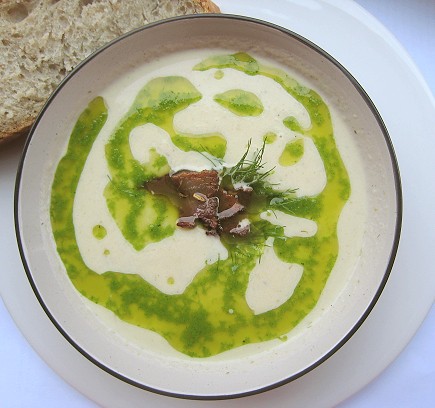
[js]
It's that time again, The Royal Food Joust entry time.
We always seem to be scrambling come the deadline for our Joust entry. It's our fault, of course, for being so indecisive. Not only do we start late, but we throw out ideas and keep discussing them and discussing them and discussing them. . . the next thing we know it's time to send in something and we still haven't decided.
This month's Joust ingredients: fennel, dairy, and parsley. We agreed on keeping it simple and just wanted to let the fennel be the main ingredient.
Here's our Cream of Fennel soup. This... is its story. (Chug-chung!)
[ts]
We start with the most important ingredient of all...
BACON! (Teehee.)
[ts]
In a pot, we rendered some bacon until crispy, adding some fennel seeds in the process. It was really nice to have crisp bacon with fennel seeds on them. We took the bacon out of the pan and set it aside.
Then, it's a straight dump-into-a-pot operation. We rough-chopped a couple of fennel bulbs (including the stalky parts) and put it in the pot with rendered bacon fat. We let it sweat for a couple of minutes, then added a glug of white wine. After a couple more minutes, we added water about 1/3 or halfway up the pot. We brought the mixture to a boil, covered the pot, and let the mixture simmer until the fennel was very tender.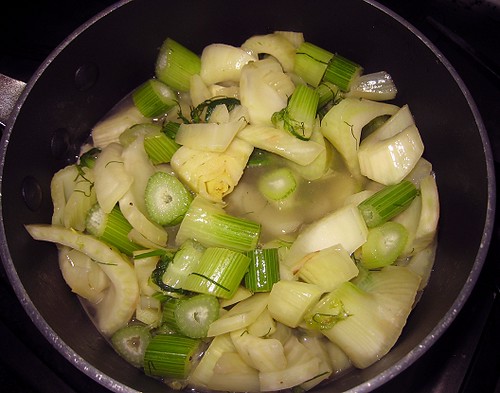
[ts]
I buzzed the mixture in the pot until well-blended. Then (so very unlike us), I strained the mixture. I put the smooth liquid back into the pot.
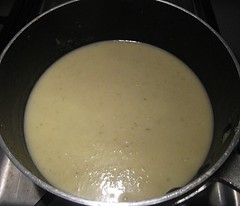
[ts]
At this stage, we added the heavy cream.
It was also at this time that we added our secret ingredient: roasted garlic! Just a little bit, maybe 1 or 2 cloves. This is completely optional, of course, but it does add depth and a little something-something to the soup.
I whisked the mixture until smooth, adjusting the seasoning (salt and pepper). The black pepper is very important to the taste of the soup. For us, anyway. But, if you prefer not to have black specks in the white soup, that's fine as well.
But wait! Where's the parsley?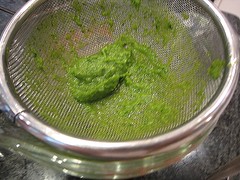 At first, we were thinking of adding the parsley right into the soup. But then, I wanted the soup to be pure and very pale. So, we made parsley oil. I blended some parsley with a little olive oil then strained the mixture. I also added salt into the mix.
At first, we were thinking of adding the parsley right into the soup. But then, I wanted the soup to be pure and very pale. So, we made parsley oil. I blended some parsley with a little olive oil then strained the mixture. I also added salt into the mix.
I was a bit lazy and didn't bother straining through a coffee filter. The result is an oil that is tad sediment-y. It doesn't affect the taste, but please be more refined than I was and use a coffee filter. =)
[js]
To serve, ladle the soup into a bowl, add a generous amount of parsley oil and garnish with crispy fennel-y bacon and some fennel fronds.
We had some homemade limpa bread -- a Swedish bread flavored with, among other things, fennel seeds -- and served that alongside. Any good, crusty bread would do, and this makes a nice lunch or a light supper.
marbly
[ts]
This is a very comforting dish, very creamy and very soothing, the anise-y mildness of the fennel bulbs supported by the subtle depth and body of the roasted garlic. There is also a wonderful contrast in textures and flavors: creamy soup vs. crispy bacon and whole fennel seeds, mild round flavor vs. salty bacon and bright, sprightly bite of the fennel seeds. The parsley oil is not merely for "garnish." A good dose of it is needed to add a fresh, verdant flavour to the smooth creaminess.
The soup is pretty even after it's all mixed up. Look at its marbly pattern!
Cream of Fennel Soup with Parsley Oil
Makes 2 meal-sized servings or 4 starter servings
1/2 cup chopped parsley
1/2 cup olive oil
3 slices bacon, sliced
1 teaspoon fennel seeds
2 medium-large fennel bulbs including stalks, roughly chopped
reserved fennel fronds
1/4 cup white wine
1 cup water
1/3 cup heavy cream
1-2 cloves roasted garlic (optional)
salt and pepper
To make parsley oil:
Boil some water in a small pot. When boiling, add chopped parsley and blanch for a few seconds. Drain and add blanched parsley to blender. Add olive oil and blend very well. Strain the mixture through a fine sieve (or line a sieve with a coffee filter). Set aside.
For the soup:
In a pot or saucepan, turn heat to medium and add bacon slices and fennel seeds. Stir occasionally until the bacon renders its fat and turns crispy. Take bacon pieces and fennel seeds out of the pot. Set aside.
Heat the bacon fat and add the chopped fennel bulbs. Sweat for a couple of minutes; do not brown. Turn heat to high and add white wine. Let the alcohol evaporate (a couple of minutes), then add the water. The water should be about 1/3 up the pot. Do not add too much water. Let the mixture boil, then cover the pot and turn the heat to low. Simmer until fennel is very tender, anywhere from 15 to 30 minutes.
When fennel is tender, puree using an immersion blender. (Or transfer contents to a blender and puree.) Strain the mixture and add the strained liquid back into the pot, over medium-low heat.
Add roasted garlic (if using), heavy cream, salt and pepper. Stir until smooth. Adjust the seasoning and consistency of the soup as you like.
To serve:
Ladle soup into bowls. Add generous amount of parsley oil in each, and divide bacon among the bowls. Garnish with fennel fronds if desired and serve with crusty bread.
This is our entry to the Royal Food Joust (created by The Leftover Queen).
[eatingclub] vancouver Royal Food Joust posts:
Dimsum Seafood Trio: Black Pearl Toast, Scallop in Nest, Jewelled Rice Cup
Cream of Fennel Soup with Parsey Oil
Ginger-Guava Jam
Lime-Marinated Pork Skewers with Ginger-Guava Jam and Five-Grain Rice
Soy Pudding Parfait with Orange-Ginger Syrup and "Streusel" Brittle
Squash Churros with Orange-Sage Hot Chocolate
Coffee Pancakes with Honey Ricotta and Black Pepper & Coffee-Crusted Bacon
Caribbean "Fish & (Banana) Chips"
Steelhead Trout and Enoki Mushrooms with Wasabi Cream Sauce We're submitting this to Culinarty's Original Recipes.
We're submitting this to Culinarty's Original Recipes.
More information here.
The Round-ups here.
Monday, September 29, 2008
Belado (and Belado Vegetables)
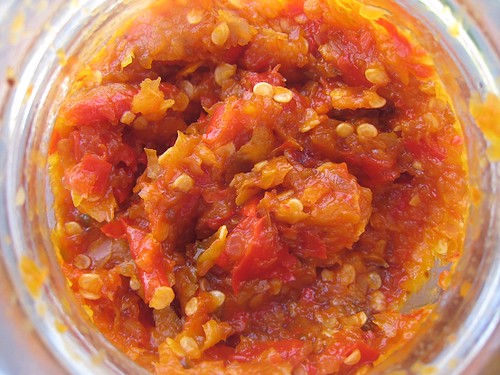
"Without chile, there is no appetite."
[ts]
Great words, indeed.
I can't say enough how we enjoy the show Food Safari: we've learned a little bit more about a variety of different foods, even being occasioned to make Thai food (here and here), Lebanese, Turkish and Spanish food, just to name a few.
This time, the episode from which we drew inspiration was their Indonesian episode. All the dishes featured were quite drool-worthy, but I thought it would be good to start with what seems like a basic sauce: belado.
[ts]
I had never heard of belado before. Searching for it on the Internet didn't yield much; I was a little surprised.
[update:
Apparently, it's usually spelled BALADO in Indonesia. Food Safari led us astray!]
In plainest terms, it is a chile sauce. Quite versatile, it seems. As per the Food Safari episode, it can be used for fried prawns, squid, fish, chicken, fried boiled eggs, eggplant, tofu, tempeh or potatoes. In other words, everything! Indonesian bloggers, perhaps you can enlighten us about it. =)
[ts]
It so happened that we grabbed a bag of these beautiful peppers from the market. Ooh, colors. So pretty. I was all set! To make belado, chile peppers, shallots and tomatoes are blended together. Oil is heated, then the mixture is seasoned with salt and sugar and cooked until it is slightly thick. Lime juice finishes it.
To make belado, chile peppers, shallots and tomatoes are blended together. Oil is heated, then the mixture is seasoned with salt and sugar and cooked until it is slightly thick. Lime juice finishes it.
Originally, I wanted to make a red chile pepper belado and a yellow chile pepper belado, then layer those in a jar.
When I puréed the yellow peppers with the onions and tomatoes, however, I realized that the resulting color would still be red. I scratched that idea.
All the peppers, regardless of color, were puréed together.
Here is the chile peppers, red onions (we didn't have shallots on hand), tomatoes, sugar and salt cooking away. I had to let it cook longer than the recipe stated because my mixture seemed to be more watery than on the show. I added the lime juice to finish it shortly thereafter.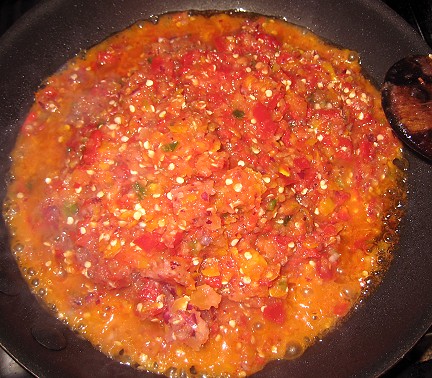
[ts]
Let me tell you, the fumes while this was cooking were quite something! Having successfully braved the fumes (barely making it out unscathed), I turned to tasting my belado.
HOLY!!!
I'm not quite the heat-freak, but I believe my heat tolerance isn't typically low. Tasting this, however, I had to take the necessary precautions and properly label it.
[ts]
I don't know how that Indonesian woman on the show could've used a whole lot for her prawns! (On the other hand, she was the one who uttered those words above about chiles and appetites.)
Having made belado, it really is quite versatile. One usage is for stir-fried vegetables.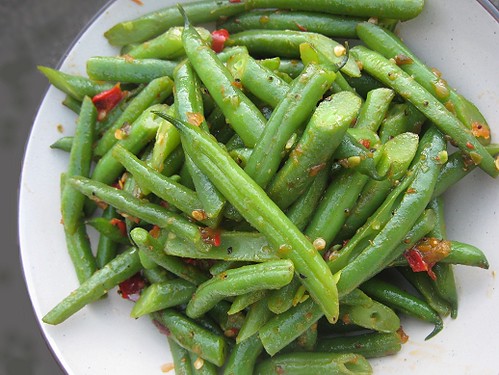
Green Beans Belado
Spinach Belado
I've also used it in a Thai-ish Beef and Gailan stir-fry (pad gka-prow).
[ts]
I use it to make other condiments: like mixing a little bit of it in pho, or adding it to soy sauce, rice vinegar and water to make a dipping sauce for CSC's dumplings.
Basically, it has become the hot sauce of choice around here.
Now we're just waiting to use it as a topping for deep-fried hardboiled eggs.
(Deep-fried hardboiled eggs! How cool is that!?)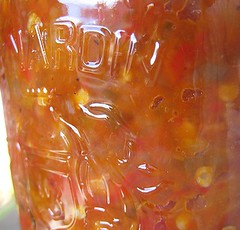 Food Safari website
Food Safari website
Food Safari: Indonesian
Belado recipe
[eatingclub] vancouver dishes inspired by Food Safari episodes:
Spanish: Tortilla de Patatas
Thai: Waterfall Beef Salad
Lebanese: Tarator-style Sauce
Thai: Thai Basil Stir-Fry (gka prow)
Lebanese: Lamb Kafta (Turkish: Lamb Kofte)
Indonesian: Belado
Moroccan: Preserved Lemons
Moroccan: Chicken Tagine
We're submitting this post to Waiter, there's something in my... Indonesian. This edition is hosted by Andrew of SpittoonExtra.
Info about Waiter, there's something in my...
on The Passionate Cook
on Cook Sister!
Saturday, September 27, 2008
Bibingka

[js]
Bibingka.
Just the word alone used to send me into a happy tizzy, of excitement and anticipation of the coming deliciousness.
Even in Manila, bibingka was only an occasional treat for us. I was told that it was a staple during midnight mass, the twelve -- or ten? or seven? -- midnights before Christmas, but never having gone to midnight mass then, I would not know.
Bibingka was not readily available and there were only a handful of places we went to that would serve it, but they also didn't serve it all of the time.
And of course, not all bibingka are created equal -- and there are some unacceptable ones that we didn't want to have even, or when, they were available.
What is bibingka anyways?
The bibingka that holds a dear, dear place in my heart was a kind of cake. It was usually lined with banana leaves, brushed with a lot of butter (or margarine, as that was the fashion those days), cooked in a claypot over wood charcoal, and served hot, freshly baked -- because there was no point in having it any other way.
Biting into that cake was pure heaven. It was usually not a very fluffy cake, so it was very easy to take into one mouthful all the things that are right with the world:
the sweet cake delicious with coconut and butter, the rich saltiness of the duck eggs and cheese interpersed with the rich sweetness of the freshly grated coconut on top, the fragrance of the banana leaves, and the aroma and flavour of the fire and smoke enveloping the rest of your senses.
It is hard to do justice to the experience. And even harder to recapture experiences of one's childhood and youth. I had been content to let bibingka stay in the back of my mind, simmering on a very low, low flame.
When coconut was chosen as the ingredient for this month's Weekend Wokking, we immediately thought of that topping of freshly grated coconut on freshly-baked bibingka. But even with that incentive, we were still on the fence whether to attempt bibingka or not. We played around with ideas for coconut in savoury applications -- but it turns out that TS does not like coconut in savoury applications at all!
[ts]
I'm just not too big a fan of savory dishes cooked in coconut milk. It's "OK", but not something I would crave or get excited about. Bibingka, on the other hand... I couldn't wait!
[js]
Okay, so bibingka it was, because that was the only thing we could agree on. We knew going in that our bibingka would not be the same as the bibingka of our childhood. We couldn't cook it over wood charcoals, for one.
We could, technically, cook it on our grill, but that would require a tad too much work at this time. We were already late in making our Weekend Wokking entry as it is. Maybe someday. We need to get one of those claypot things first.
We needed a recipe for bibingka and that's where the confusion started for me.
See, bibingka apparently is also a generic term for "cake" -- or is it cakes made from rice? I don't know. When I was looking for recipes online, I came upon lots of bibingka recipes, but some of them would be the
bibingka cassava: a kind of dessert made from grated cassava, which is totally different from the bibingka I like.
bibingka malagkit: translated, "sticky bibingka," and this seems to be some sort of sticky sheet cake made from glutinous rice. . .and I don't know if this is what we used to call "biko" when we were kids.
In recent memory, I recall ordering the kind of bibingka I like in some restaurants as "bibingka espesyal." Well, because they are special indeed.
We found a recipe that's promising (and easy) and we decided to go with this recipe for now. (See our recipe based on it below.)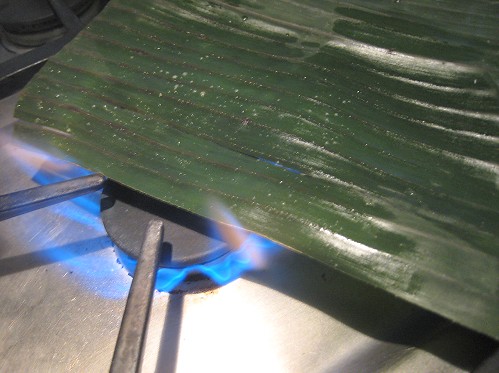
[ts]
First, preparing the banana leaves.
Since having great difficulty working with banana leaves the first time we used them (to wrap tilapia), we since learned that one had to "wilt" them first before using. That simply entails holding the leaf over the flame until the top of the leaf turns bright green and shiny. It was a little fascinating to watch.
We didn't know what size pan to use, so we guessed and used a 9-inch pie plate. We lined it with banana leaves and brushed it with butter.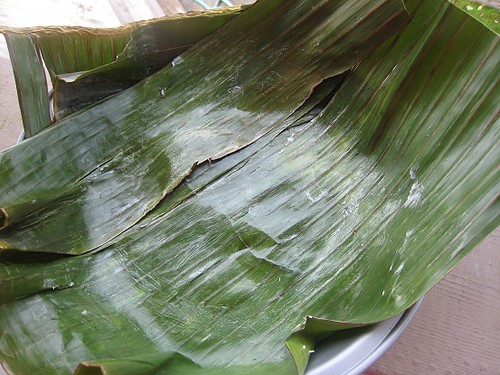
[ts]
To make the batter, we beat eggs, sugar and melted butter together. Then we combined rice flour, a little glutinous rice flour and baking powder. We added coconut milk and the egg mixture to the dry ingredients and mixed well. Into the banana leaf-lined pan it went.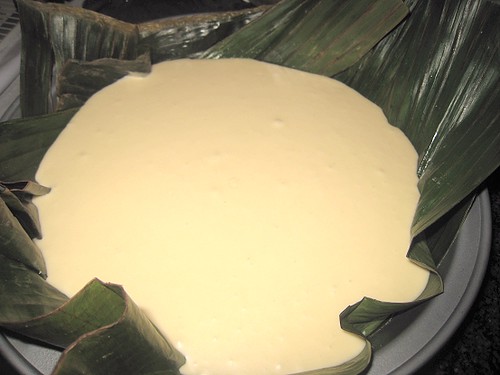
Into a 350F-degree oven for about 20 minutes. We used the toothpick test to check for doneness.
While the bibingka was baking, we prepared the toppings. Of course, first and foremost, the freshly-grated coconut.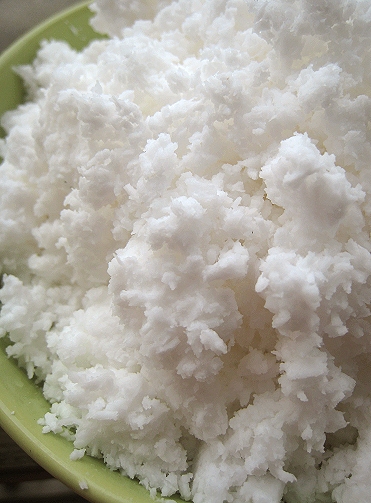
[ts]
Actually, we didn't have the energy or mental preparedness to get fresh coconuts and extract the flesh ourselves, so we just bought frozen grated coconut.
Additional sugar (we used brown sugar) is also used as a topping.
[js]
Traditionally, toppings included salted duck eggs, but when I went to get salted duck eggs, I couldn't find any. I used to see them beside the chicken eggs -- but yesterday, they were gone! I went to our two Chinese supermarkets and both of them didn't have any to sell.
[ts]
We didn't know what kind of cheese was used for the topping as well. However, to get our saltiness quotient missing from the absent salted duck eggs, we used a mixture of Parmigiano-Reggiano and Pecorino Romano.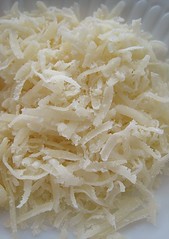

left: Parmigiano-Reggiano; right: Pecorino Romano
[ts]
As for the quantities of the toppings, it's up to you. Go hog wild!
When the bibingka finished baking, we were unsure what to do next. Were we supposed to just put the toppings on and call it a day? The recipe we were using called for adding the salted duck eggs and baking for an additional 5 minutes. But, we didn't have the duck eggs.
So, I brushed the top with melted butter then proceeded to pile up the cheeses, brown sugar and grated coconut. However, the whole thing looked anemic. We then decided to put the bibingka with toppings under the broiler.
The banana leaves caught fire! But I pressed on until the top at least had some "burn" marks. (It still could've used more scorching for that smoky aroma.)
Ta-da!
[ts]
Of course, of course, it could use even more grated coconut on top!
Ta-da redux!
See, doesn't it look better with even more coconut?
[ts]
The bibingka was very fluffy and high; I don't think they're supposed to be that high. Next time, we'll either use a bigger baking dish or do 2 9-inch pie plates. That way, there'll be more topping per cake! It's all about the toppings for me!
[js]
This bibingka was delicious! We had it on the table and I couldn't stop eating it.
The freshly grated coconut (okay, frozen freshly grated coconut) and the cheeses on top was heavenly. And having the banana leaves burned by the broiler added a little taste of fire to the bibingka which was most, most welcome.
I still missed having the salted duck eggs. Oh well. I figure this was going to be our trial run anyways and the bibingka recipe would have to undergo several revisions. The next revision, we'll have the duck eggs.
[ts]
It was so good. We deceived ourselves and pretended we weren't going to have a lot, so we never actually sliced a serving of it onto a plate. However, whenever we'd pass by the table, we'd eat a little piece. And each time, it was like having it for the first time all over again! Our eyes would widen and say -- with mouths full -- "Ang sarap!" ("It's so good!")
[js]
Was it similar to the bibingka of our past? Not quite -- but we're working on that. This was a very good attempt and so I'm happy with it. If we didn't have other bibingka to compare it with, this would an unqualified hit. But it does have all those other bibingka to contend with, not fair perhaps, but hey, that's life.
Another [eatingclub] bibingka moment:
Foodbuzz 24, 24, 24: A Starry. Starry Night in Vancouver -- Evoking the Philippine Christmas Spirit
More bibingka information
Market Manila has an approximation of a bibingka "oven."
http://www.marketmanila.com/archives/bibingkahan-pinoy-terra-cotta-oven
Here's another post about freshly-made bibingka, which I've never had the good fortune of having, by the way.
http://scentofgreenbananas.blogspot.com/2005/09/pampanga-freshly-made-bibingka.html
Pinoy Cook's post about bibingka and puto bumbong, miso de gallo (midnight mass) favorites.
http://www.pinoycook.net/bibingka-and-puto-bumbong/
Salted Duck Eggs information.
http://en.wikipedia.org/wiki/Salted_duck_egg
And of course, Wikipedia's bibingka information.
http://en.wikipedia.org/wiki/Bibingka
Recipe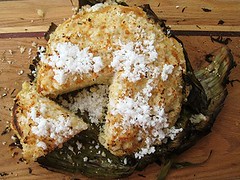 Bibingka
Bibingka
Based on Bibingka from Simply Anne's
Makes two (2) 9-inch bibingka
Ingredients
"wilted" banana leaves
3 eggs
½ cup sugar
¼ cup butter, melted
2 cups rice flour
¼ cup glutinous rice flour
1 tbsp baking powder
1 cup thick coconut milk
melted butter for brushing
toppings
sugar (white or brown)
grated fresh coconut
sliced salted eggs
grated cheese (Pecorino Romano, Parmiggiano-Reggiano)
Method
To "wilt" banana leaves, hold them over a flame until the "greener" side becomes shiny.
Preheat oven to 350F. Line two (2) 9-inch cake/pie pans with wilted banana leaves. Brush banana leaves with butter.
Beat eggs in a bowl until foamy. Add sugar and butter and beat until fluffy.
Mix the rice flour, glutinous rice flour and baking powder in a bowl. Add coconut milk. Blend well.
Add the egg mixture to the coconut-flour mixture, mixing until smooth.
Divide the batter in half and pour each half into lined pans. Bake for approximately 15 minutes. (Do toothpick test.)
Switch oven to BROIL.
Brush top of each cake with butter, and top with toppings of your choice: sliced salted eggs, grated cheese, sugar, grated freshg coconut. Broil until top is charred/golden.
Serve with more grated coconut and sugar, if desired.
Enjoyed this post? Why not subscribe to our blog? Subscribe via reader or subscribe via email. Thank you! |
eatingclub vancouver Weekend Wokking posts:
Ravioli "Caprese": Tomato, Basil, Bocconcini
Eggplant "Clafouti"
Bibingka
Pumpkin Congee w/ Pumpkin "Beignets" & Sesame-Roasted Pumpkin Seeds
Chicken, Broccoli and Cheese w/ Pipián Verde
Adobo Mushroom Tart
Duck and Orange Crêpes with Orange-White Wine Sauce
Almond Eggplant "Bisteeya" (Bastilla)
"Mashed Potato Beef Burger" (Red-skinned Potato Salad in Taiwanese Sacha Cheeseburger)
Korean Soybean Sprouts Pancake (Kongnamul Jeon)
Lemon Chamomile Tiramisu
Cilantro Horchata
Strawberry Cilantro Salsa, on Grilled Flank Steak
Duck Enchiladas with Chipotle Peanut Salsa
Clear Oxtail Soup with Corn, Cabbage and Potatoes
Beijing Pickled Cabbage
Salsa Romesco ("Queen of the Catalan Sauces!")
Aguadito de Pollo (Peruvian Chicken Soup)
Bangus Belly à la Bistek (Milkfish Belly with Onions, Calamansi and Soy Sauce)
White Pork with Garlic Sauce, Two Ways (蒜泥白肉)
Mr. Zheng's Soupy Tomatoes and Eggs with Tofu (蕃茄雞蛋跟豆腐)
Steamed Fish and Tofu with Chinese Black Beans
Spinach and Cheese with Puff Pastry, Three Ways

We're submitting this recipe to Weekend Wokking, a world-wide food blogging event created by Wandering Chopsticks celebrating the multiple ways we can cook one ingredient.
The host this month is Ivy of Precious Pea.
If you would like to participate or to see the secret ingredient, check who's hosting next month.
Check out all Weekend Wokking Roundups.
[eatingclub] vancouver Filipino food
Bibingka
Mama's Ampalaya (Bitter Melon)
Faux Kamote-Que
Philippine-Style Chicken "BBQ"
Fried Hasa Hasa (Mackerel)
"Savory" Chicken Wings
Sinamak (Chile-infused Vinegar)
Pan-roasted Halibut w/ Fava Beans, Potato-Onion Cakes & Bagoong Butter Sauce
Bulalo & Bangus: an even simpler Filipino meal
Baked Tahong (Mussels)
Adobo Kangkong (Adobo Water Spinach)
Oyster Torta (Oyster Omelette)
Chicken Tinola (Chicken Soup w/ Green Papaya & Pepper Leaves)
(Chinese) Roast Pork Belly / Lechon
Tilapia wrapped in Banana Leaves
Pork Belly, Two Ways
Chicken Adobo
Embutido
Salabat (Ginger Tea)
Lechon Manok (Philippine Roast Chicken) & Lechon Sauce
"Chinese Adobo" Clams and Oysters
Bistek (Citrus Beef with Caramelized Onions)
Beef Kaldereta (Beef Stew with Bell Peppers)
Atsara (Green Papaya Pickle)
Sardinas na Bangus (Milkfish in the style of Sardines) and Pressure Cooker Fear
Friday, September 26, 2008
Greek Meatball Soup (Giouvarlakia)
[js]
When I saw this meatball soup from Peter of Souvlaki for the Soul, I was intrigued and I wanted to try it.
It turned out that TS had the same idea.
"You know that soup from Peter G?"
"Yeah?"
"Let's try it."
Most of all, I loved the fact that this was a soup made with water, not stock. I finally felt validated when I read Mark Bittman and Michael Ruhlman endorsing -- well, I guess not quite endorsing -- but telling us that it is okay to use water in some dishes (instead of using much disliked store-bought stock).
We had some ground pork in the house, but we couldn't seem to find the right insertion point for the soup. Last two weeks, for some reason, we actually mustered up enough energy to prepare semi-complete meals (that is, enough food) for every single day of those two weeks.
When we finally had the opportunity a few days ago, the ground pork was all gone. (It was made into CSC's ever-popular dumplings.)
After our weekly Saturday grocery run, ground pork was replenished. I wanted to try the soup with pork-beef meatballs, but come Sunday, I was too lazy to head out again for some ground beef.
We would have to make our version of giouvarlakia with just ground pork.
A bad photo post
[ts]
A-ya! Such bad photos! We made this soup at night. We have no light source!
Anyway, I started by putting a pot of water to boil.
For the meatballs, I buzzed onions, parsley and dill in the food processor and mixed that with ground pork, eggs, olive oil and uncooked rice. Seasoned with salt and pepper too, of course.
To speed things up, I took the pot of boiling water off the stove and placed it beside my workspace. I rolled each meatball in flour and straight into the pot each went.
Then, back to the stove to boil and simmer.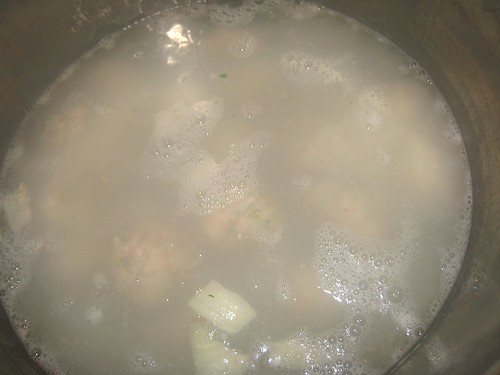
[ts]
It looked a little scary at first (see above), but don't worry!
When the meatballs were cooked, I added avgolemono to the pot: I beat a couple of eggs with lemon juice, then tempered that first with some of the hot soup before adding the whole mixture to the pot.

[js]
I think we have some Greek in us, because the meatballs really, really tasted familiar. It must be the onions and the rice. Because we used just ground pork for the meatballs, the soup was very mild-tasting, almost milky, so the lemon in the avgolemono added such a welcome high note to the soup. I couldn't stop sipping and sipping and sipping. . .
. . .until it was all gone.
The complete recipe is here: Giouvarlakia from Souvlaki for the Soul
[ts]
On a photography note, HELP!
The darktimes have descended. We now have no light source, as it gets dark early (3pm or so). Any lighting/photography tips for taking pictures indoors?
Or I should say, any cheap-cheap-cheap tips that we can use?
We need all the help we can get! (As demonstrated by the horrendous photos herein.) Help us! Thanks in advance!
eatingclub vancouver Greek
"Greek" Calamari
Simple Greek Meal
Caper Salad
Greek Meatball Soup (Giouvarlakia)
Marinated Feta
Greek Shrimp with Feta
Greek Ribs with Tzatziki
Mushroom Ragu Pastitsio
Spanakorizo (Greek Spinach Rice)
Zucchini Ribbons Salad with Anchovy Dressing
Souvlaki (Pork and Chicken)
Tomato Bread Salad, Greek-style
Grilled Fish Fillet on Oregano
Pastéli (Greek Sesame Snaps)
We're submitting this to Regional Recipes, a blogging event created by Blazing Hot Wok that celebrates food from all over the world. The inaugural event is hosted by Darlene herself! The region is Greece.
The inaugural event is hosted by Darlene herself! The region is Greece.
Regional Recipes information
Our Regional Recipes posts:
Greek Meatball Soup (Giouvarlakia)
Simmered Saba Mackerel with Daikon Radish (Saba Oroshi-ni)
Thai Fried Chicken
Roast Pork Belly with Puy Lentils
Beef "Ribbon" Kebab (Pasanda Kabab) with Cilantro Chutney
Canadian Onion Soup with Oka Cheese
Muffuletta
Börek with Beef Filling
Korean Pork Bulgogi (with Muu Namul, Kong Namul)
Lobster Congee from a Lobster Feast
Pork Jowl (Pork Cheeks) with Brown Sugar Rub
Beef Salpicao
Cuban Arroz con Salchichas (Yellow Rice with Vienna Sausages)
Cuban Pastelitos de Guayaba y Queso (Guava and Cheese Pastries)
Vietnamese Spring Roll (Cha Gio)
Grilled Fish Fillet on Oregano
Pastéli (Greek Sesame Snaps)
Thursday, September 25, 2008
Caper Salad

[ts]
Not long after Peter of Kalofagas returned from summer in Greece, he wrote about this caper salad. The moment I saw it, I knew I had to make it. (Hello! Capers!)
The recipe called for boiling potatoes then mashing them with capers, green olives, garlic, wine vinegar, red onions, chives, dill, oregano and olive oil (of course). So, I did just that! Well, we didn't have green olives on hand, so I just went heavy-handed with the capers. We even had Greek olive oil and so used that.
It was easy to make and of course, utterly delicious. I especially liked the convenience of serving it at room temperature.
It was so good that CSC didn't even have a second thought in betraying our super-appetite-stoker: we had some grilled flank steak and chimichurri (again!) during the same meal and she completely shunned the chimichurri! She said she liked her steak just with this caper salad. (I repeat, she shunned chimichurri, that super-appetite-stoker!)
Grand endorsement, indeed!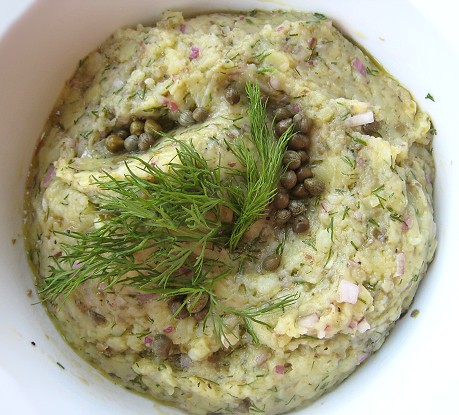
The complete recipe is here: Caper Salad from Kalofagas
eatingclub vancouver Greek
"Greek" Calamari
Simple Greek Meal
Caper Salad
Greek Meatball Soup (Giouvarlakia)
Marinated Feta
Greek Shrimp with Feta
Greek Ribs with Tzatziki
Mushroom Ragu Pastitsio
Spanakorizo (Greek Spinach Rice)
Zucchini Ribbons Salad with Anchovy Dressing
Souvlaki (Pork and Chicken)
Tomato Bread Salad, Greek-style
Grilled Fish Fillet on Oregano
Pastéli (Greek Sesame Snaps) We're submitting this post to Weekend Herb Blogging, a world-wide food blogging event created by Kalyn's Kitchen with the goal of helping each other learn about cooking with herbs and unusual plant ingredients.
We're submitting this post to Weekend Herb Blogging, a world-wide food blogging event created by Kalyn's Kitchen with the goal of helping each other learn about cooking with herbs and unusual plant ingredients.
If you'd like to participate, see who's hosting next week. WHB is hosted this week by Haalo of Cook (almost) Anything At Least Once.
Wednesday, September 24, 2008
Foccacia
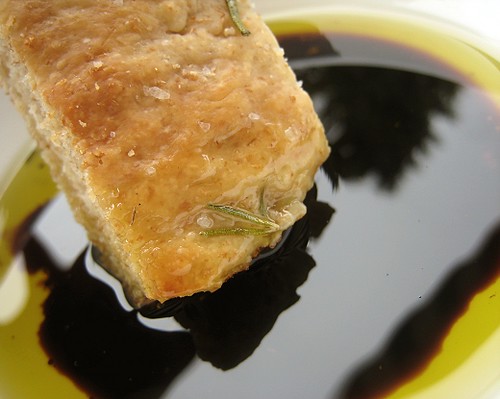
[js]
Not very foccacia-ey this one, because I made the mistake of not letting my dough rise for the second time.
I wanted to make pizza but pizza was for dinnertime and I was stuck in that limbo-time between lunch and dinner. After I made the dough for the pizza and had let it rise for an hour, I still had a couple of hours till dinner.
I wanted a snack while I waited for dinner. So, I made another batch of dough.
I used Mario Batali's dough recipe from his new book, Italian Grill.
3 1/4 cups all-purpose flour
2 tsp active-dry yeast
1 tbsp salt
1 tbsp sugar
1 cup water
1/4 cup white wine
2 tbsp extra virgin olive oil
[js]
I made my dough whole wheat: Instead of the 3 1/4 cups of all-purpose flour, I did 1-1/2 cups of whole wheat flour and 1-1/2 cups of all-purpose.
I was very surprised to find some white wine in our fridge. It has probably been there for a long time and was now turning into vinegar. Oh well, I figure the most damage it would do would be to add some sourness to the dough.
Anyway, I mixed all the dry ingredients and incorporated all of the wet until they came together. I kneaded the dough until it became smooth and sprang back when poked.
In an oiled bowl, I covered the dough and waited for it to rise. After it had risen to twice its size, I punched it down. The dough at this stage is ready to be made into pizza or foccaccia.
[js]
To make my "foccacia," I added two tablespoons more of olive oil and stretched some dough into a square pan, added some rosemary, and sprinkled the dough with salt. I baked it for about 20 minutes at 450 degrees.
I should have let it rise for another 30 minutes in the pan, but I forgot.
After its time in the oven, it was perfectly "eatable". I like it, of course, with some balsamic vinegar and extra virgin olive oil.
It's a little bit softer than traditional foccaccia but it's good enough for me.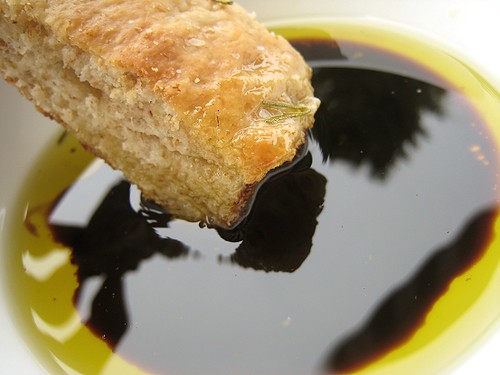
Breads we've done from the book:
Artisan Deli-Style Rye Bread
Brioche
Swedish Limpa Bread
European Peasant Loaf
Olive Oil Bread with Onions and Olives
Other breads we've made before:
No-Knead Bread, Two Kinds
Sesame Seed Buns
Foccacia
Potato Cornmeal Foccacia
Whole Wheat Challah
Tuesday, September 23, 2008
Pork Soup with Hairy Gourd and Peanuts (Chinese Soup #2)
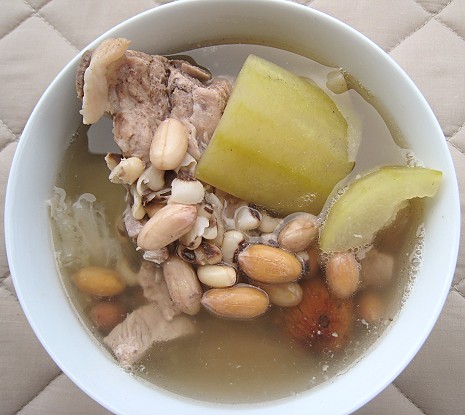
[ts]
Yes, another day of "convenience" food.
This time, I chose a more conventional mix of ingredients.
"Pork Soup w/ Hairy Gourd & Peanuts"
[ts]
This "simpler" soup just has hairy gourd, pork and pork backbone, honey dates, peanuts and cowpeas (black-eyed peas).
It's nourishing and helps skin stay moisturized!
(Again, this doesn't cool the "hot" (yang) from the body! I think I have too much yang! Perhaps next time I'll get those cooling-the-yang packs.)
Honey dates, peanuts and black-eyed peas on the left. Pork, porkbone and hairy gourd on the right. (Hairy gourd is just some cucumber-like/squash-like vegetable, but I like the name.) Then it's your basic dump-into-a-pot-and-add-water operation.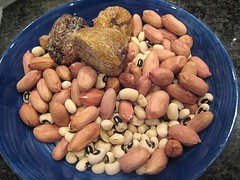
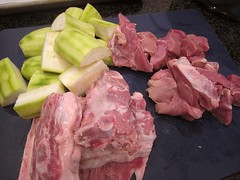

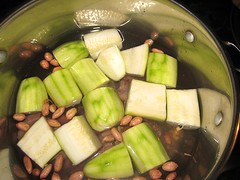
[ts]
This was definitely better than the sharkbone version. I'm still unsure whether the peanuts are supposed to be really soft or not. The meat got tender faster than the peanuts! Next time I'll wait until the peanuts are soft; I think I'll like that even more. Of course, the hairy gourd was very nice, similar to cooked cucumbers, which I like. (First discovered making Hainan Chicken and testified to in Watermelon Cucumber Curry.)
I'm not too big a fan of pork broth, so I think I'll try some other packs with different proteins.
Kelly (CSC's university-mate) has made this comment regarding these "convenience packs":
I made that soup too [pork with sharkbone] and it did smelled fishy. My favourite is the watercress one. It is brewing as we speak.
Then it's the one with melon and carrots for its sweetness. I also just like eating the pork bones with soy sauce.
The chicken feet one was gelatinous and fatty. I plan on trying the black chicken one some day. My parents ended up buying a bunch of funky Chinese stuff for me and then combined them in zip loc bags. I just need to add pork bones. I have enough to be set for life. ;)
-----
Pork Soup with Shark Bone and Seaweed (Chinese Soup #1)
Pork Soup with Hairy Gourd and Peanuts (Chinese Soup #2)






